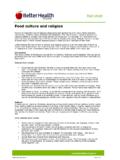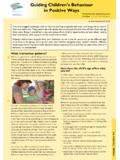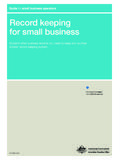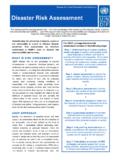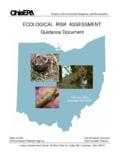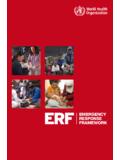Transcription of 6 STEPS TO RISK MANAGEMENT - Imagine Education
1 6 STEPS TO RISK MANAGEMENTD isclaimerThis Guide provides general information about the obligations of persons conducting a business or undertaking and/or persons in control of premises and workers under the Work Health and Safety Act 2011. The Guide gives some suggestions for complying with these obligations. However, this Guide is not intended to represent a comprehensive statement of the law as it applies to particular problems or to individuals or as a substitute for legal advice. Full details of legal obligations and responsibilities are set out in the Work Health and Safety Act 2011 referred to in this Guide.
2 If you refer to the legislation you should take care to ensure that you use the most up-to-date version, available from You should seek legal advice if you need assistance on the application of the law to your document is produced by WorkSafe ACT. All rights information contained in this document cannot be reproduced in whole or in part without the prior permission of WorkSafe ACT. ACT Government (WorkSafe ACT) 20126 STEPS TO RISK MANAGEMENTINTRODUCTION 5 GOOD MANAGEMENT PRACTICE 6 STEP 1: HAZARD IDENTIFICATION 7 STEP 2: RISK IDENTIFICATION 9 STEP 3: RISK assessment 10 STEP 4: RISK CONTROL 11 STEP 5: DOCUMENTING THE PROCESS 13 STEP 6: MONITORING AND REVIEWING 1445 This guide aims to help you assess and manage health and safety risks in the MANAGEMENT is an important way to protect your workers and your business, while at the same time complying with the law.
3 It helps you focus on the risks that really matter in your workplace the ones with the potential to cause real harm. In many instances, straightforward measures can readily control risks , for example ensuring spillages are cleaned up promptly so people do not slip, or cupboard drawers are kept closed to ensure people do not trip. For most, that means simple, cheap and effective measures to ensure your most valuable asset your workforce is law does not expect you to eliminate all risk, but you are required to protect people as far as reasonably practicable . This guide will help you to achieve STEPS outlined in this guide are not the only way to conduct an WHS risk MANAGEMENT process, there are other methods that work well, particularly for more complex risks and circumstances.
4 However, we believe this method is the most straightforward for most t overcomplicate the process. In many organisations, the risks are well known and the necessary control measures are easy to apply. If you are a person in control of a business or undertaking, you probably already know whether, for example, you have workers who move heavy loads and so could harm their backs, or where people are most likely to slip or trip. If so, check that you have taken reasonable precautions to avoid injury. If you run a small organisation and you are confident you understand what s involved, you can do the assessment yourself.
5 You don t have to be a health and safety expert. If you work in a larger organisation, you could ask a health and safety advisor to help you. If you are not confident, get help from someone who is competent. In all cases, you should make sure that you involve your workers or their representatives in the process. They will have useful information about how the work is done that will make your assessment of the risk more thorough and effective. But remember, you are responsible for seeing that risk MANAGEMENT is carried out Risk MANAGEMENT is recognised as an integral part of good MANAGEMENT practice. It is an interactive process consisting of STEPS , which, when undertaken in sequence, enable continual improvement in decision making.
6 Risk MANAGEMENT is the term applied to a logical and systematic method of establishing the context, identifying, analysing, treating, monitoring and communicating risks associated with any activity, function or process in a way that will enable organisations to minimize losses and maximize opportunities. Risk MANAGEMENT is as much about identifying opportunities as avoiding or mitigating losses. Australian Standard AS/NZS 4360:1999 Risk Hazard and RiskHazards and risks are not the same hazard is an act or condition that has the potential to cause damage to plant or equipment, or result in an illness or injury.
7 Hazards can be categorised by the type of outcome, energy exchange process or geographic location, manual handling hazards, slips and trips, laundry hazards. A risk is the likelihood of a specific consequence occurring. risks are usually expressed in terms of likelihood and consequences, the risk of contracting Ross River Fever while working in Tasmania might be considered to be very many cases the terms hazard and risk are used interchangeably, however, remember that hazard has a more general application and risk a specific application. Risk MANAGEMENT has 3 main stages, risk identification, risk assessment and risk control.
8 In many cases in the early phase of identifying risk, we may in fact be looking to identify all the risks associated with a particular activity or process, in which case the activity is more properly referred to as hazard identification, risk assessment and then risk Approach to the MANAGEMENT of Hazards and associated RisksThe aim of the process is to minimise the likelihood or consequence of a particular risk to a level that is minimal and that we are prepared to accept. The risk MANAGEMENT process includes:1. Identification of a hazard2. Identification of the associated risk3. assessment of the risk (which includes:) the likelihood the consequence assigning a priority for rectification4.
9 Control of the risk (using a hierarchy of control measures consisting of [in order of preference]):a) Eliminationb) Substitutionc) Isolationd) Engineering controlse) Administrative controls (SOPs, training)f) Personal Protective Equipment5. Documentation of the process6. Monitoring and review of the MANAGEMENT PRACTICE7 This is the process of examining each work area and work task for the purpose of identifying all the hazards which are inherent in the job . Work areas include but are not limited to machine workshops, laboratories, office areas, agricultural and horticultural environments, stores and transport, maintenance and grounds.
10 Tasks can include (but may not be limited to) using screen based equipment, audio and visual equipment, industrial equipment, hazardous substances and/or dangerous goods, teaching/dealing with people, driving a vehicle, dealing with emergency situations, construction, you need to work out how people could be harmed. When you work in a place every day it is easy to overlook some hazards, so here are some tips to help you identify the ones that matter: Walk around your workplace and look at what could reasonably be expected to cause harm. Ask your workers or their representatives what they think. They may have noticed things that are not immediately obvious to you.

